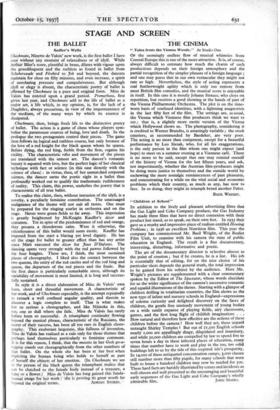STAGE AND SCREEN
THE BALLET
Sadler's Wells Checkmate, Ninette de Valois' new work, is the first ballet I have seen without any moment of relaxedness or of idyll. While Arthtir Bliss's score, plentiful in brass, dilates with vigour upon the grandiloquent and the ruthless as found in ballet from Scheherezacie and Firebird to• job and beyond, the dancers maintain for close on fifty minutes, and even increase, a spirit of unrelaxing pressure and compulsiveness. But although idyll or elegy is absent, the characteristic poetry of ballet is affirmed by Checkmate in a pure and original form. Miss de Valois has entered upon a grand period. Prometheus, first given last year, and Checkmate add to the life of ballet as a major art, a life which, in my opinion, is, for the lack of a Diaghilev, always precarious, in view of the impermanence of the 'medium, of the many ways by which its essence is dissipated.
Checkmate,-then, brings fresh life to the distinctive poetry of ballet. The action is a game of chess whose players sym- bolise the paramount sources of being, love 'and death. In the prologue the two protagonists control their pieces. The game then follows its logical and ruthless course, but only because of the love of a red knight for the black queen whom he spares. Before dying, the red king, feeble from the first, regains his virility. The characteristic roles and movement of the pieces are translated with the utmost art. The dancer's romantic beauty is equated with love, but the perfect logic of her classical technique with fact or science (in this case directly with the science of chess) : in virtue, then, of her unmatched corporeal science, the dancer earns the poetic right in a ballet thus profoundly worked out to qiialify the mathematic ruthlessness of reality. This claim, this power, underlies the poetry that is characteristic of all true ballet.
To realise this claim, then, without intrusion of the idyll, is a novelty, a peculiarly feminine contribution. The unassuaged malignance of the theme will not suit all tastes. One must be prepared for the ringing scarlet in orchestra and on the stage. Never were green fields so far away. This impression is greatly heightened by McKnight Kauffer's decor and costumes. Yet in spite of the predominance of red and orange, they possess a thunderous calm. Were it otherwise, the relentlessness of this ballet would seem exotic. Kauffer has imposed from the start a blaring yet level dignity. He has set the stage for ballet to greater effect than has any artist since Mira executed the decor for jeux D'Enfants. The dancing opens very strongly with the red pawns followed by the four knights. These are, I think, the most sustained pieces of choregraphy. I liked also the contact between the two queens, the entry of the red castles and of the red king and queen, the departure of the red pieces and the finale. But the first dance is particularly remarkable since, although its variability of movement is most limited, it is long and success- fully sustained.
In style it is a direct elaboration of Miss de Valois' own keen, short and thrustful movement. A characteristic of her work, and of Checkmate especially, is the attempt repeatedly to remark a well confined angular quality, and therein to discover a logic complete to itself. That is what makes her so serious a choregrapher, and like Nijinska in this, too, one so dull where she fails. Miss de Valois has rarely before been so successful. A triumphant continuity flowing beyond the musical phrase, characteristic of the Russians, the secret of their success, has been all too rare in P.nglish chore- graphy. This exuberant largeness, this fullness of invention, Miss de Valois has realised as a rule only for those themes that perhaps lend themselves particularly to feminine comment. It is for this reason, I think, that the musette in her Gods go-a- begging stands out choregraphically from the other numbers of that ballet. On the whole she has been at her best when depicting the human being who holds to herself as part of herself the objects of her emotion. (In Checkmate we see in the person of the black queen the triumphant malice that can be clutched to the female body instead of a treasure, a baby or a flower.) Miss de Valois has long gained this-funda- mental image for her work : she is proving its great worth far






















































 Previous page
Previous page